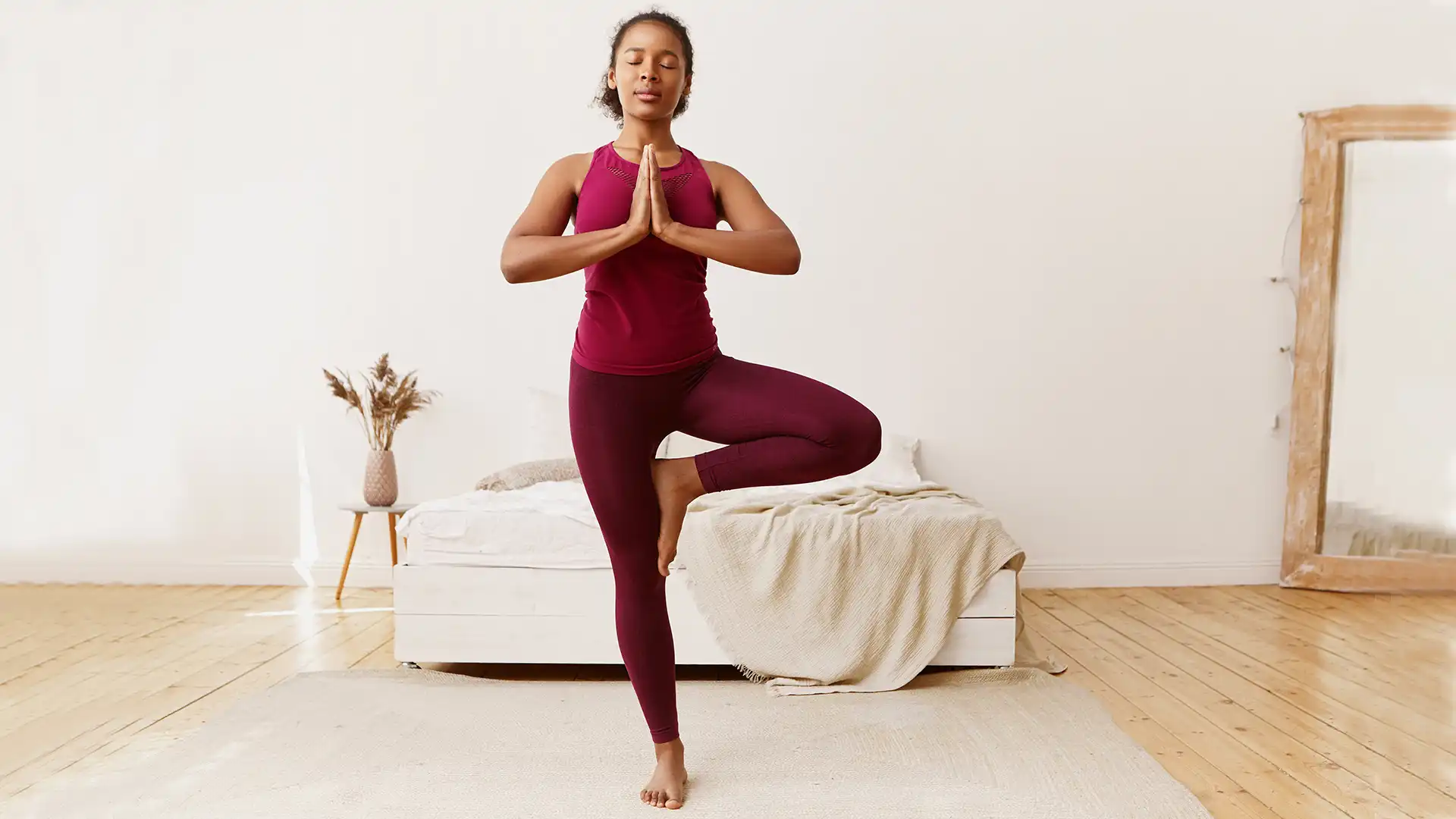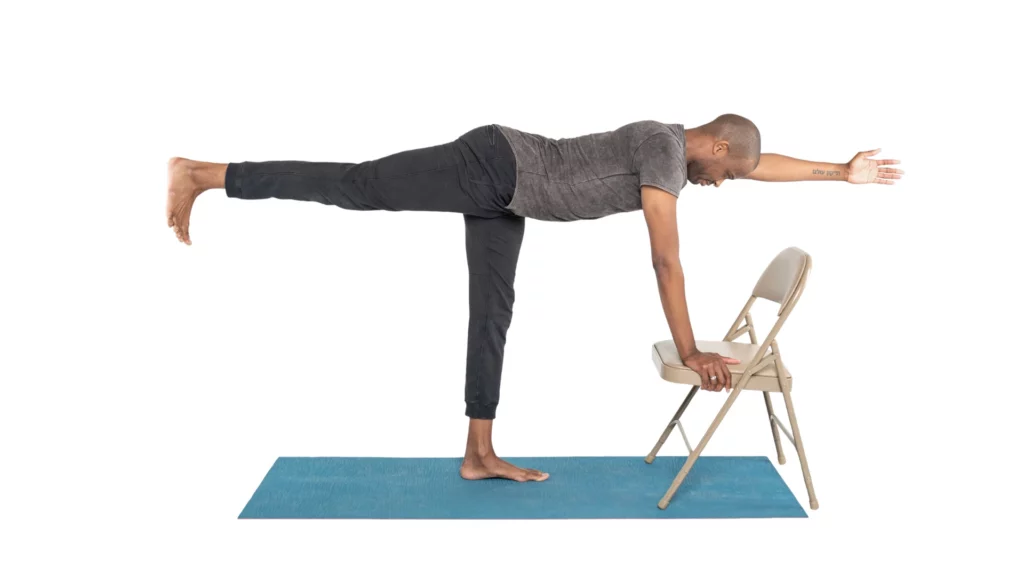10 Yoga Balance Tips for Developing Proprioception and Maintaining Good Balance

Article At A Glance
Yoga Balance poses are foundational in yoga practice. This article explores 10 yoga balance tips to help develop greater proprioception and the ability to maintain better balance. If you have mastered the basic balancing yoga poses and want to keep improving your balance, it’s necessary to keep challenging yourself. Included are several recommendations that allow you to keep progressing in your ability to balance for years to come!
Maintaining our ability to balance is essential as we age. About a third of the population over the age of 65 takes a fall each year. At age 80, half of the seniors fall annually. Falling is the leading cause of death by injury among people aged 65 and older. In this article, we explore 10 yoga balance tips that might help prevent falls.
Balance poses are foundational in yoga practice. These yoga poses help you develop and maintain your body’s ability to balance. If you are new to yoga—and to balance poses—we will explore a few basic techniques and principles to get you started.
To safely explore balancing poses you have never practiced before, start out by practicing the versions that use props or a wall for support before moving on to the classic yoga pose. If you’re fearful, you can practice any pose with your back to a wall that you can lean back into if you feel yourself losing balance.
If you have mastered the basic balancing yoga poses and want to keep improving your balance, it’s necessary to keep challenging yourself. So our list of techniques includes several recommendations that will allow you to keep progressing in your ability to balance for years to come!
Whatever your current level is, you should practice yoga poses that challenge your balance with a non-judgmental attitude, as negative self-talk can sabotage you. As you start to practice, notice your thoughts. If they tend to be negative, such as, “I suck at Tree Pose,” try consciously taking a more neutral approach, such as, “Let’s see what I can do today…” And keep in mind that even if you fall (safely, of course!), you are still benefitting tremendously by practicing your balancing yoga poses, so practicing is your real aim, rather than staying upright!

Tip 1. How Often to Practice Yoga
Since you typically only practice a few balance poses in an active practice, it’s a good idea to include one or more balance yoga poses in every active practice that you do. However, to avoid injuries from overuse, make sure you vary which balance poses you practice. For example, if you’re working on Vrksasana (Tree Pose), do that only every other time and try a version of Virabhadrasana III (Warrior III) on alternate days.
Tip 2. How Long to Hold the Yoga Poses
Hold your balance poses until you notice that your leg, or whichever body part is supporting you, is quivering, and then try to hold 2-3 seconds longer. Rest a few seconds before repeating on the second side. If you are only able to do 10- to 30-second holds, rest briefly after completing both sides and repeat the pose a second time. Over time, gradually work your way up to holds of 1 to 2 minutes.
Tip 3. Balance Your Yoga Practice
For improving balance, it’s important to practice a wide variety of balance poses as well as strength, flexibility, and agility yoga poses. So be sure to practice a wide variety of poses throughout the week and month rather than just doing the same poses every day. Besides the standing balance poses, we recommend practicing yoga balancing poses where you balance on other parts of your body.
Try Vasisthasana (Side Plank) pose variations to work on hands and the sides of your feet. Try Navasana (Boat Pose) variations to work on your buttocks area. Try Parsva Balasana (Hunting Dog Pose) to work on your shins as well as your hands. And to keep your mind fully engaged and avoid relying on your body memory of practicing your yoga poses in the past, vary the order in which you do your poses as well.
Tip 4. Mindfulness
Because maintaining awareness while you balance—rather than just throwing yourself into a balance yoga pose and hoping for the best—is what will help you improve, you should mainly practice poses that are accessible enough so you can practice them mindfully. As you practice, focus on your sensations of being on and off balance and making whatever subtle adjustments are necessary to steady yourself. As you make progress with the accessible poses, you can gradually add in a few more challenging poses or variations.
To develop your proprioception, take the time to really feel your own alignment in every single yoga pose that you do. Are your arms even in Virabhadrasana II (Warrior II)? Are your knees actually straight in your standing poses? Is your head really aligned directly over your torso? Then take your proprioception to another level by working with more subtle alignment cues.
For example, you could work with your shoulder blades, your collarbones, your inner thighs, or something even more esoteric like your psoas muscles. Sometimes there is an area you are not used to sensing and, at first, it will be hard to feel something there. But the more you bring your mind to it, the easier it will be to sense that area and eventually to move it.
Tip 5. Mental Focus in Yoga
Practicing balance yoga poses trains your mind as you return your focus again and again to maintaining balance. You notice shifting sensations—the feeling of being on or off balance—and when extraneous thoughts take you away from your movements. However, if you are having trouble focusing, you can meditate and practice structured breathing practices to improve your mental focus in general, benefitting your balance both inside and outside the yoga room.
Tip 6. Challenge Yourself
It’s important to continue to challenge your balance and keep moving to the edge of stability where you almost—or do the first few times—lose your balance. You can do this by varying the yoga poses you do, how you use your vision, the type of surface you balance on, and the amount of distraction that’s in your environment.
Tip 7. Vary Your Yoga Poses

- After starting with basic static poses and dynamic sequences, add more challenging yoga poses and practices. From there, search out new poses or variations, make up new versions of existing balance poses, or even invent your own balance poses. Some guidelines:
- After you master simple yoga poses, progress to more complex poses or sequences of poses. This adds new variables for your mind and body, from simple to complex. Try more advanced balancing poses that you learn about in an intermediate/advanced yoga classes. Or, after learning two balancing poses independently, such as Tree Pose and Warrior III Pose, you could create a dynamic sequence that combines the two.
- After you master familiar yoga poses, progress to inventing new versions of them that challenge your balance. For example, you could modify Tree Pose by shifting your hip toward your standing leg and tipping your torso and arms to your lifted leg side.
- After you master static balance yoga poses, progress to dynamic balance poses, such as dynamic Warrior III Pose, to challenge yourself with balance in motion.
Tip 8. Remove or Change Your Vision
After you’re comfortable in a balance pose with your eyes open, you can take vision out of the equation. This helps improve both proprioception and exteroception, as you have to rely on your internal sense of where you are in space to balance, as well as your vestibular system. Try practicing in a darkened room or with your eyes completely closed. You can also change your vision by keeping your eyes open but changing the position of your head, by looking up or looking down, and by turning your head.
Tip 9. Vary the Surface You Balance On
Once you are comfortable balancing on a stable surface, such as a wood floor or a thin yoga mat, gradually move on to more unstable surfaces. Some possibilities include a rug or carpet, a foam mat, a foam block, and even a firm mattress. If it’s possible to practice yoga outside, try some yoga balance poses on the grass or sand. We also recommend practicing on an uneven surface, such as with half your foot on your mat and the other half directly on the floor.
Tip 10. Change Your Yoga Environment
When you’re ready for real-world challenges, you can try practicing in a distracting environment, such as at a park or at the beach. You can also create a distracting environment in your yoga room by practicing with a talkative yoga friend or let some children or pets “help” you practice. You can also add “cognitive distraction drills” to your practice by chanting or even tossing a small ball or bean bag around while you practice your yoga balance tips.
Reprinted with permission from Yogaforhealthyaging.blogspot.com
Nina Zolotow, RYT 500, Editor-in-Chief of the Yoga for Healthy Aging blog, is both a yoga writer and a yoga teacher. She trained to be a yoga teacher at The Yoga Room in Berkeley, California, has studied yoga therapy with Shari Ser and Bonnie Maeda, and is especially influenced by the teachings of Donald Moyer. She also studied extensively with Rodney Yee and is inspired by the teachings of Patricia Walden on yoga for emotional healing. Her special area of expertise is yoga for emotional well-being (including yoga for stress, insomnia, depression, and anxiety), and she teaches workshops and series classes on yoga for emotional well-being, stress management, better sleep, home practice, and cultivating equanimity. Nina is the co-author, with Rodney Yee, of two books on yoga: Yoga: The Poetry of the Body and Moving Toward Balance, both of which are widely available, and is currently writing a book with Baxter Bell on Yoga for Healthy Aging for publication in 2017.


